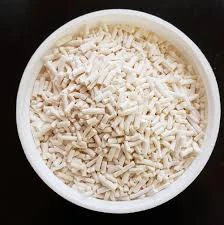
anti caking agent in food
Understanding Anti-Caking Agents in Food
In the food industry, the need for maintaining product quality and enhancing consumer experience has led to the introduction of various food additives. Among these, anti-caking agents play a vital role in ensuring that powdered and granulated foods remain free-flowing and easy to use. This article explores what anti-caking agents are, their functions, types, and their implications for health and safety.
What Are Anti-Caking Agents?
Anti-caking agents are substances added to powdered or granulated materials to prevent clumping and ensure that the product maintains its desired consistency and flow characteristics. When ingredients such as salt, sugar, or flour are stored, they can absorb moisture from the air, leading to the formation of lumps or a hardened mass. This not only affects the appearance of food products but also complicates their use in cooking and baking.
Functions of Anti-Caking Agents
The primary function of anti-caking agents is to promote free-flowing characteristics in granular or powdered products. Here are a few specific functions
1. Moisture Absorption Many anti-caking agents can absorb moisture, thereby reducing the likelihood of clumping.
2. Surface Coating Some agents work by coating the particles of the main ingredient, creating a barrier that prevents moisture from coming into contact with the particles.
3. Reducing Friction By creating a smooth surface on the particles, anti-caking agents help reduce friction between them, allowing for easier pouring and mixing.
Types of Anti-Caking Agents
Anti-caking agents can be categorized into two groups natural and synthetic.
anti caking agent in food

1. Natural Anti-Caking Agents These include substances like cornstarch, powdered cellulose, and magnesium carbonate. They are derived from natural sources and are often preferred by consumers looking for cleaner labels.
2. Synthetic Anti-Caking Agents Common examples of synthetic agents include silica gel, sodium aluminosilicate, and calcium silicate. These synthetic options tend to be more effective at very low concentrations and can function in a variety of environmental conditions.
Common Uses
Anti-caking agents are widely used in a variety of food products, including
- Salt and Sugar These basic ingredients often have anti-caking agents added to ensure they flow freely and do not clump together in humid conditions.
- Spices and Seasonings Ground spices can benefit from anti-caking agents to avoid caking after packaging, ensuring that consumers can easily sprinkle them onto their dishes.
- Baking Powder and Baking Soda To maintain the efficacy of leavening agents, anti-caking agents are commonly included, preventing premature reaction and clumping.
Health and Safety Considerations
The addition of anti-caking agents in food is generally regarded as safe when used within established guidelines. Regulatory bodies like the Food and Drug Administration (FDA) and the European Food Safety Authority (EFSA) assess the safety of food additives, including anti-caking agents. Most of these agents are recognized as safe, provided they are used in appropriate quantities.
However, as with any food additive, there are considerations for some individuals. For example, those with certain allergies or sensitivities may react to specific synthetic agents. Therefore, it is important for consumers to read labels carefully, especially if they are concerned about potential allergens.
Conclusion
Anti-caking agents are essential in the food industry, contributing to the quality, usability, and aesthetic appeal of various products. By preventing clumping and promoting free flow, these agents enhance the cooking and baking experience for consumers. As consumers become increasingly conscious of food additives, the trend toward natural anti-caking agents is likely to grow. Thus, understanding these substances not only informs better consumption choices but also highlights the intricate science behind food production. Whether natural or synthetic, anti-caking agents play a pivotal role in keeping our kitchens stocked with usable ingredients.
-
Pure Sodium Dichloroisocyanurate Dihydrate | Powerful DisinfectantNewsAug.29,2025
-
Industrial Chemicals: Quality & Purity for Every IndustryNewsAug.28,2025
-
Nitrile Rubber Honoring Strict Production StandardsNewsAug.22,2025
-
Aspartame Ingredients Honoring Food Safety ValuesNewsAug.22,2025
-
Fertilizer for Balanced Plant NutritionNewsAug.22,2025
-
Cyanide Gold Processing with High Purity AdditivesNewsAug.22,2025
-
Formic Acid in Textile Dyeing ApplicationsNewsAug.22,2025
Hebei Tenger Chemical Technology Co., Ltd. focuses on the chemical industry and is committed to the export service of chemical raw materials.
-

view more DiethanolisopropanolamineIn the ever-growing field of chemical solutions, diethanolisopropanolamine (DEIPA) stands out as a versatile and important compound. Due to its unique chemical structure and properties, DEIPA is of interest to various industries including construction, personal care, and agriculture. -

view more TriisopropanolamineTriisopropanolamine (TIPA) alkanol amine substance, is a kind of alcohol amine compound with amino and alcohol hydroxyl, and because of its molecules contains both amino and hydroxyl. -

view more Tetramethyl Thiuram DisulfideTetramethyl thiuram disulfide, also known as TMTD, is a white to light-yellow powder with a distinct sulfur-like odor. It is soluble in organic solvents such as benzene, acetone, and ethyl acetate, making it highly versatile for use in different formulations. TMTD is known for its excellent vulcanization acceleration properties, which makes it a key ingredient in the production of rubber products. Additionally, it acts as an effective fungicide and bactericide, making it valuable in agricultural applications. Its high purity and stability ensure consistent performance, making it a preferred choice for manufacturers across various industries.





